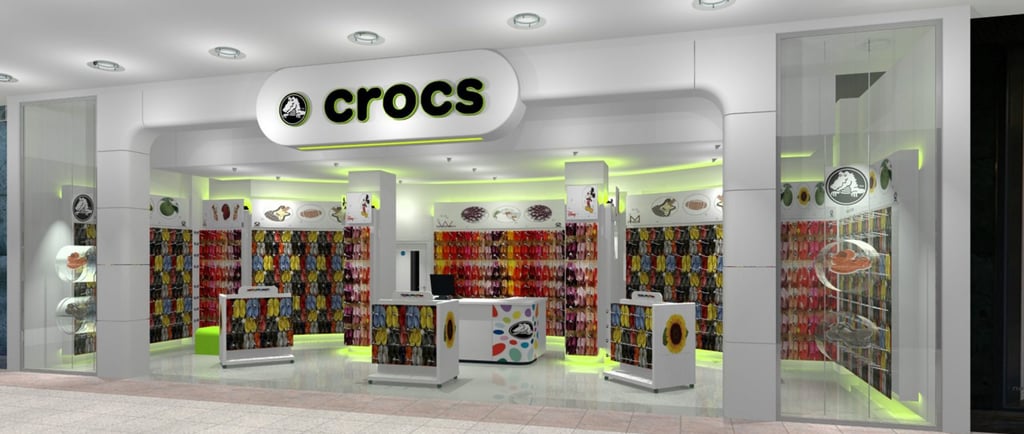👟 Welcome to Crocsy Vibe – Where Comfort Meets Global Style! 🌈
Crocs Behind the Scenes: How Crocs Are Built for Tomorrow
See what goes into every step with Crocs: advanced manufacturing, innovative materials, and a vision for sustainability. The journey from factory to your feet is all about comfort, efficiency, and responsibility—proof that the future of footwear is as exciting as it is eco-friendly.
SHARAD RAJGURU
7/22/20257 min read


Introduction to Crocs Innovation
Founded in 2002, Crocs has established itself as a leader in the footwear industry, renowned for its innovative designs that prioritize comfort and practicality. Initially introduced as a boating shoe, the brand quickly evolved, capturing the attention of consumers who valued ease of use and a unique aesthetic. The signature Croslite material, which is lightweight and breathable, has become synonymous with the brand. This material not only provides exceptional support and cushioning but also enables the footwear to be easily cleaned and maintained, aligning with modern lifestyle demands.
As the global market evolves, Crocs has continuously adapted its manufacturing processes and product offerings. The company recognizes that the future of fashion is not just about style but also sustainability. Thus, Crocs is committed to incorporating eco-friendly practices in its production methods, demonstrating a deep understanding of environmental impacts associated with footwear manufacturing. From utilizing recycled materials to implementing energy-efficient processes, Crocs is making strides towards reducing its carbon footprint and supporting the circular economy. These efforts reflect a growing trend among consumers who prioritize sustainability in their purchasing decisions.
Moreover, to future-proof its innovations, Crocs actively engages in research and development, exploring new technologies that enhance product performance and durability. The brand’s ambition extends beyond mere aesthetics and comfort; it seeks to create footwear that resonates with the evolving needs of its consumers while promoting responsible consumption. By focusing on versatility and functionality, Crocs appeals to a diverse audience, allowing the shoes to seamlessly transition from casual wear to professional settings. Understanding these innovations and manufacturing processes is essential to comprehend how Crocs is building a sustainable tomorrow, committed to meeting both consumer demands and environmental responsibilities.
The Role of Material Science in Crocs
Materials science plays a critical role in the design and manufacture of Crocs footwear, most notably through the use of Croslite foam. This unique, proprietary material is lightweight, buoyant, and provides a cushioning effect that enhances overall comfort. The innovative characteristics of Croslite foam make it highly suitable for footwear that is intended for extended wear, which is one of the core attributes Crocs aims to deliver. Research and development teams continuously explore the properties of various materials to keep Crocs at the forefront of both comfort and performance.
In the pursuit of quality, Crocs has committed to integrating sustainable materials into their production processes. The company acknowledges the growing concerns surrounding environmental impact and is actively seeking alternatives that reduce carbon footprint without sacrificing the functionality of their products. Through strategic collaborations with material scientists and engineers, Crocs is making strides in sourcing eco-friendly materials that resonate with consumer preferences for sustainability. Such efforts not only enhance the brand's appeal but also align with a broader movement towards responsible manufacturing in the footwear industry.
The advanced engineering of materials used by Crocs extends beyond Croslite. The brand has been exploring various textures and formulations, which has enabled the creation of models that cater to a diverse audience. From the classic clogs to more fashion-forward silhouettes, the adaptability of their materials contributes to their versatility in meeting different lifestyle needs. This ongoing commitment to research ensures that Crocs remains a prominent player in the market, as their innovative approach to material science continues to shape the future of comfortable and sustainable footwear.
Cutting-Edge Manufacturing Processes
At the forefront of innovative manufacturing, Crocs employs a range of cutting-edge techniques that significantly enhance the efficiency and quality of its products. Central to these advancements is the integration of automated systems and smart robotics, which are instrumental in streamlining the production process. These technologies are designed to operate with remarkable precision, thereby reducing the potential for human error and ensuring that each pair of Crocs meets the brand's high standards.
The use of robotics in Crocs manufacturing allows for speed and accuracy that would be challenging to achieve through traditional methods. For instance, automated machinery can mold, color, and assemble the footwear while maintaining consistency across large production runs. This not only accelerates the packaging and shipping timelines but also minimizes labor intensity, enabling workers to focus on tasks that require human insight and creativity.
Moreover, Crocs places a strong emphasis on sustainability, and its advanced manufacturing processes play a crucial role in this endeavor. By utilizing smart technology, the company is able to monitor resource usage closely, effectively minimizing waste. Additionally, efficient manufacturing practices translate into lower energy consumption, further contributing to the sustainability goals that Crocs has set for itself. The environmentally conscious approach extends beyond the production line; the firm also prioritizes the selection of eco-friendly materials, which are integrated into their products without compromising quality.
Incorporating these state-of-the-art manufacturing techniques not only improves operational efficiency but also enhances the overall quality of Crocs products. By merging innovation with sustainability, Crocs is well-equipped to remain a leader in the footwear industry while paving the way for a more environmentally friendly future. With a commitment to excellence in manufacturing, Crocs is indeed building for tomorrow.
Sustainable Practices and Global Efforts
Crocs has increasingly prioritized sustainability throughout its manufacturing processes and corporate initiatives, aiming to mitigate its environmental impact significantly. The company's commitment to sustainable practices is evident in various initiatives that highlight its multifaceted approach to ecological responsibility. One critical aspect of Crocs' strategy involves forging partnerships with organizations dedicated to environmental preservation. By collaborating with entities focused on sustainability, Crocs leverages collective expertise to develop innovative solutions and further enhance its ecological agenda.
Additionally, Crocs has instituted comprehensive recycling programs designed to minimize waste and promote circularity. Through these programs, the company encourages consumers to return their old footwear for recycling, allowing materials to be repurposed and preventing them from ending up in landfills. This not only contributes to resource conservation but also reinforces the company's commitment to responsible consumption. Such initiatives showcase Crocs' proactive stance on reducing its carbon footprint and supporting global sustainability goals.
The incorporation of eco-friendly materials is another cornerstone of the company’s sustainability strategy. Crocs has made substantial strides in integrating sustainable resources into its product lines. For instance, the use of recycled and bio-based materials not only decreases reliance on virgin materials but also contributes to lowering greenhouse gas emissions during production. This emphasis on sustainable material choices aligns with the broader industry trend towards environmentally responsible manufacturing practices. Through its dedication to sustainability, Crocs aims to be a frontrunner in the footwear sector, demonstrating that comfort and style can coexist harmoniously with environmental stewardship.
Innovative Design Philosophy
The innovative design philosophy behind Crocs footwear is centered around the principle of comfort, which serves as the cornerstone of its development process. This approach recognizes that comfort is not a mere luxury but a fundamental requirement for everyday footwear. As a result, Crocs places significant emphasis on user experience, prioritizing the needs and preferences of its wearers in every stage of design and production.
One of the key aspects of this design philosophy is the integration of user feedback. Crocs actively engages with its community to gather insights on how their footwear is utilized in various settings. This feedback loop allows the company to adapt its designs, ensuring that they meet the practical demands of users, whether in casual, outdoor, or professional environments. The incorporation of user suggestions leads to continuous improvements, making Crocs not only comfortable but also versatile and functional.
Moreover, staying attuned to market trends plays an essential role in Crocs' product development process. The brand continually monitors shifts in consumer preferences and lifestyle changes, which influences the design of upcoming models and styles. By embracing innovative materials and construction techniques, Crocs maintains a commitment to durability and functionality, reinforcing their reputation for legendary comfort. This evolution demonstrates an agile design strategy that balances the emergence of new trends with the timeless essence of comfort and practicality that Crocs is known for.
This forward-thinking approach positions Crocs as a leader in the footwear industry, with designs that reflect contemporary aesthetics while adhering to the essential principle of comfort. As the brand continues to evolve, its steadfast commitment to innovation ensures that Crocs will remain a preferred choice for those seeking reliable and comfortable footwear. Through this innovative design philosophy, Crocs is not just building shoes; it is creating a future where comfort and practical use intersect seamlessly.
Looking Ahead: The Future of Crocs
The future of Crocs appears to be firmly rooted in innovation and sustainability, with the company aiming to redefine the landscape of the footwear industry. As technology rapidly evolves, Crocs is expected to leverage advanced materials and manufacturing processes that prioritize both performance and environmental responsibility. Innovations such as 3D printing and biodegradable materials are anticipated to play a significant role in the next generation of Crocs shoes. This forward-thinking approach is not only beneficial for enhancing wearability but also aligns with a broader movement towards sustainable fashion.
Moreover, advancements in material science are likely to lead to the development of lighter, more durable materials that will increase comfort without sacrificing style. For instance, integrating smart textiles that can adapt to various conditions could enhance the functionality of Crocs, making them suitable for a wider array of activities. Coupled with improved cushioning technology, this will ensure that Crocs remain at the top of consumer preferences by providing superior comfort and performance.
Sustainability is another cornerstone of Crocs’ future. The brand has already made strides in incorporating eco-friendly practices into its production lines, and this trend is expected to intensify. Utilizing recycled and renewable materials will be key to reducing the environmental footprint of Crocs footwear. Furthermore, the company might embrace circular economy principles, allowing for guided recycling programs that encourage customers to return their used Crocs for refurbishment or recycling, thus minimizing waste.
In conclusion, the future of Crocs looks promising as the brand is poised to remain a leader in the footwear industry. By adopting innovative technologies and sustainable practices, Crocs aims not just to create footwear for the present, but for a more sustainable future, reinforcing its commitment to both quality and environmental stewardship.
Conclusion: The Journey of Crocs
As we reflect on the remarkable journey of Crocs, it becomes clear that the brand has established itself as a true pioneer in the footwear industry. Crocs’ unique approach to manufacturing and design emphasizes a harmonious blend of innovation, comfort, and sustainability, which together shape the ethos of the company. By utilizing advanced materials such as Croslite, Crocs delivers footwear that not only provides exceptional comfort but also enhances functionality across various settings.
In an age where sustainability has become paramount, Crocs has reaffirmed its commitment to eco-conscious practices. The company actively seeks to reduce its environmental footprint through innovative recycling initiatives and sustainable sourcing of materials. This forward-thinking approach not only aligns with the growing consumer demand for responsible manufacturing but also sets a standard for other brands within the industry to follow. Crocs has effectively positioned itself as a leader in this realm, showcasing how thoughtful design can coexist with environmental stewardship.
Moreover, the company's willingness to adapt to changing trends—be it through collaborations with designers or the introduction of new styles—demonstrates a keen understanding of the evolving preferences of its customer base. This adaptability ensures that Crocs remains relevant and appealing, igniting enthusiasm among its loyal followers while attracting new customers.
As we look ahead, the anticipation grows regarding what Crocs will continue to achieve. With a firm foundation based on comfort and a commitment to sustainable practices, the future appears bright for this iconic brand. It is exciting to consider how Crocs will innovate and inspire, maintaining its status as a frontrunner in merging style with practicality while prioritizing the planet's well-being.

Get in touch
Address
3721 Single Street
Quincy, MA 02169
Contacts
123-456-7890
info@email.com
